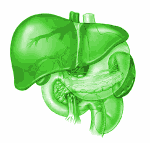Liver biopsy – now rarely needed

Liver biopsies are now rarely used in the UK. This is because non-invasive alternatives are now widely available.
A liver biopsy measures liver damage by taking a small sample of your liver to look at under a microscope.
However, because this is an invasive test, it is now only used when other tests are not appropriate.
Information for when biopsy is still recommended
Biopsy can still be sometimes needed to assess liver disease. However, because it is an invasive test, it only used in the UK when other tests are not appropriate. A biopsy provides information about both the stage and the grade. It can also identify other causes of liver disease.
A liver biopsy involves having a needle inserted between the ribs, and into the liver. The needle then clips and removes several tiny samples of liver.
The procedure can be painful, and carries a small risk of complications (1-3%). These include a risk of puncturing other organs or bleeding, and a much smaller risk of complication that is fatal (0.1% to 0.01% – one in 1000 to 1 in 10,000).
Some clinics in the UK use a transjugular (TJ) liver biopsy. This is where the liver is reached via the large vein in your neck which reduces the risk of some complications from needle biopsies.
However, even a biopsy is not perfect. This is because there can be errors in taking the sample and in reviewing it. The results may not be accurate if the sample is too small, or if it came from an area in the liver that is either more or less damaged than the rest.
Because a biopsy is not pleasant, many people are reluctant to have this test. Although some doctors still think that biopsy offers the best way to measure liver damage, it is becoming more common to use other tests, such as FibroScan.
When is a biopsy important?
A biopsy is sometimes recommended if the results from a FibroScan and blood tests are not clear or to diagnose other causes of hepatitis.
If a biopsy shows less liver damage it makes it easier to wait for new drugs. Moderate to serious liver scarring shows the importance of treatment to prevent liver damage from getting worse.
Only an experienced doctor with a good record of successful biopsies should perform these tests.
The doctor should also use an ultrasound scan to guide the needle and reduce the chance of puncturing another organ. The ultrasound also helps pick which area of damaged liver to sample.
Ask your doctor about options for pain management during and after the procedure. Ask other people about their experiences. It may be easier to find a good doctor by talking with people who have had a biopsy.
One of the main obstacles to HCV treatment is the liver biopsy. So, right now I am considering treatment, because I see a lot of people dying from hep C and I’ve had it for a long time. My viral load is OK, my liver enzymes are OK, but we know that the only way to know the real situation is a liver biopsy. To be honest, I am ready to start treatment tomorrow, but I don’t want a doctor to put a needle in my liver.
Recent research is looking at less invasive alternatives to biopsy (see Measuring liver stiffness).
Interpreting biopsy results
There are different systems for measuring liver inflammation and fibrosis from a biopsy. All range from zero to a maximum score with a higher number indicating more inflammation or fibrosis.
Two scoring systems, Metavir and Ishak, are commonly used to grade and stage liver biopsy results.
The Metavir system scores inflammation from A0-A3 and fibrosis from F0-F4. The Ishak system scores inflammation from 0 to 18 and fibrosis from 0 to 6, (see table below “Interpreting biopsy scores”).
UK (BHIVA) guidelines define mild liver damage as a modified Ishak fibrosis score of 3 or less and a Metavir fibrosis score of 2 or less. Moderate liver damage is an Ishak inflammatory score of 4 or more and/or a fibrosis score of 3 to 5.
However, these scoring systems are not used in every hospital and some clinics prefer to just stage biopsies as mild, moderate or cirrhosis.
Interpreting biopsy scores
| Inflammation | Fibrosis | |
| Metavir | A0 – A3 | F0-F4 |
| Ishak | 0 – 18 | 0 – 6 |
YouTube video
www.youtube.com/watch?v=PXTdt_ZtlgM
Dr Douglas Dieterich from the Mount Sinai Hospital in New York performs a biopsy.
Last updated: 17 August 2017.
